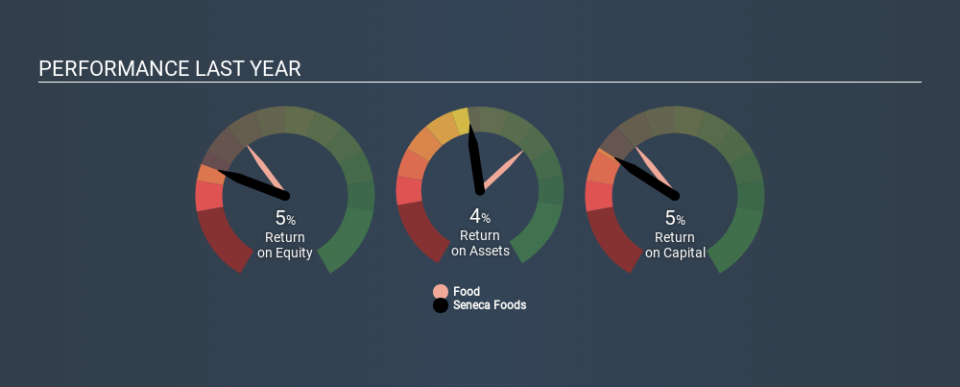Why You Should Care About Seneca Foods Corporation’s (NASDAQ:SENE.A) Low Return On Capital

Today we'll evaluate Seneca Foods Corporation (NASDAQ:SENE.A) to determine whether it could have potential as an investment idea. In particular, we'll consider its Return On Capital Employed (ROCE), as that can give us insight into how profitably the company is able to employ capital in its business.
First, we'll go over how we calculate ROCE. Then we'll compare its ROCE to similar companies. Finally, we'll look at how its current liabilities affect its ROCE.
Understanding Return On Capital Employed (ROCE)
ROCE measures the 'return' (pre-tax profit) a company generates from capital employed in its business. In general, businesses with a higher ROCE are usually better quality. Ultimately, it is a useful but imperfect metric. Renowned investment researcher Michael Mauboussin has suggested that a high ROCE can indicate that 'one dollar invested in the company generates value of more than one dollar'.
So, How Do We Calculate ROCE?
Analysts use this formula to calculate return on capital employed:
Return on Capital Employed = Earnings Before Interest and Tax (EBIT) ÷ (Total Assets - Current Liabilities)
Or for Seneca Foods:
0.051 = US$39m ÷ (US$933m - US$173m) (Based on the trailing twelve months to December 2019.)
So, Seneca Foods has an ROCE of 5.1%.
View our latest analysis for Seneca Foods
Is Seneca Foods's ROCE Good?
One way to assess ROCE is to compare similar companies. In this analysis, Seneca Foods's ROCE appears meaningfully below the 8.7% average reported by the Food industry. This performance is not ideal, as it suggests the company may not be deploying its capital as effectively as some competitors. Setting aside the industry comparison for now, Seneca Foods's ROCE is mediocre in absolute terms, considering the risk of investing in stocks versus the safety of a bank account. Investors may wish to consider higher-performing investments.
Seneca Foods's current ROCE of 5.1% is lower than 3 years ago, when the company reported a 7.4% ROCE. Therefore we wonder if the company is facing new headwinds. You can see in the image below how Seneca Foods's ROCE compares to its industry. Click to see more on past growth.
When considering ROCE, bear in mind that it reflects the past and does not necessarily predict the future. ROCE can be deceptive for cyclical businesses, as returns can look incredible in boom times, and terribly low in downturns. ROCE is, after all, simply a snap shot of a single year. How cyclical is Seneca Foods? You can see for yourself by looking at this free graph of past earnings, revenue and cash flow.
Seneca Foods's Current Liabilities And Their Impact On Its ROCE
Liabilities, such as supplier bills and bank overdrafts, are referred to as current liabilities if they need to be paid within 12 months. Due to the way ROCE is calculated, a high level of current liabilities makes a company look as though it has less capital employed, and thus can (sometimes unfairly) boost the ROCE. To counter this, investors can check if a company has high current liabilities relative to total assets.
Seneca Foods has current liabilities of US$173m and total assets of US$933m. As a result, its current liabilities are equal to approximately 19% of its total assets. This is a modest level of current liabilities, which would only have a small effect on ROCE.
The Bottom Line On Seneca Foods's ROCE
If Seneca Foods continues to earn an uninspiring ROCE, there may be better places to invest. But note: make sure you look for a great company, not just the first idea you come across. So take a peek at this free list of interesting companies with strong recent earnings growth (and a P/E ratio below 20).
If you like to buy stocks alongside management, then you might just love this free list of companies. (Hint: insiders have been buying them).
If you spot an error that warrants correction, please contact the editor at editorial-team@simplywallst.com. This article by Simply Wall St is general in nature. It does not constitute a recommendation to buy or sell any stock, and does not take account of your objectives, or your financial situation. Simply Wall St has no position in the stocks mentioned.
We aim to bring you long-term focused research analysis driven by fundamental data. Note that our analysis may not factor in the latest price-sensitive company announcements or qualitative material. Thank you for reading.

